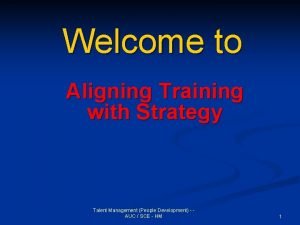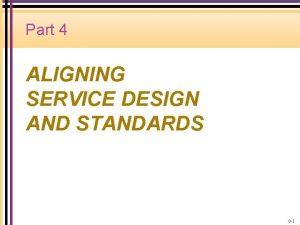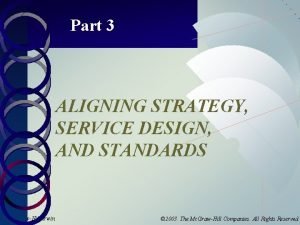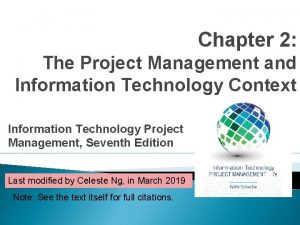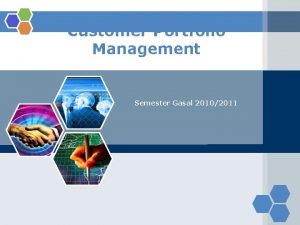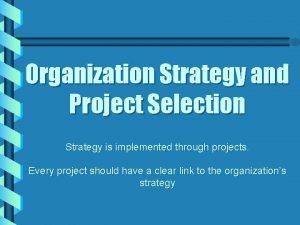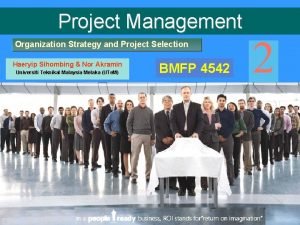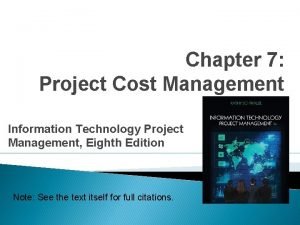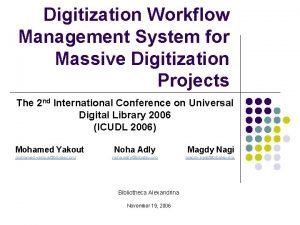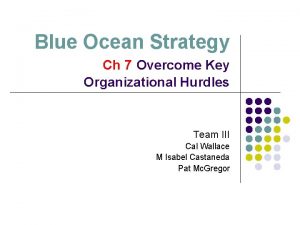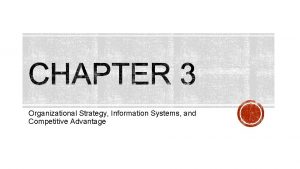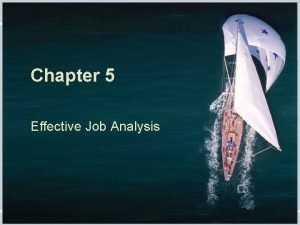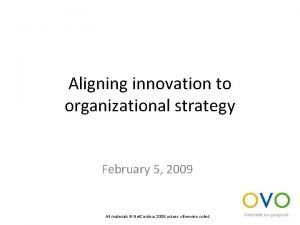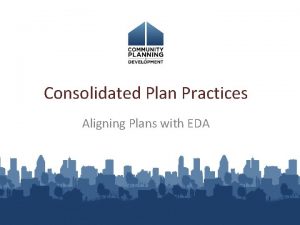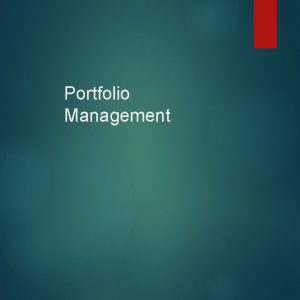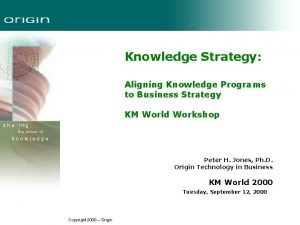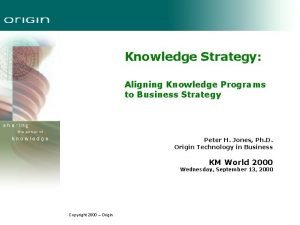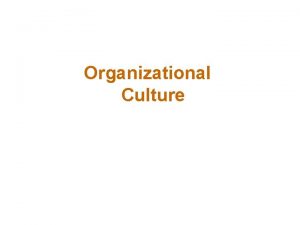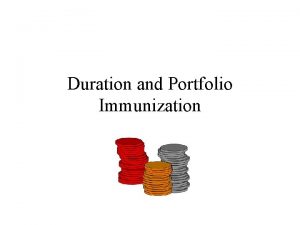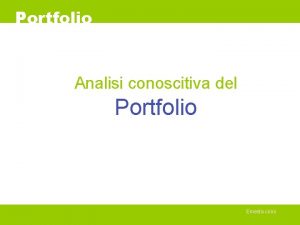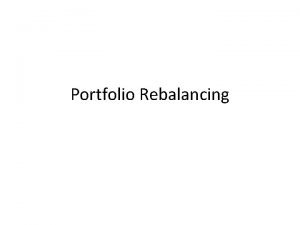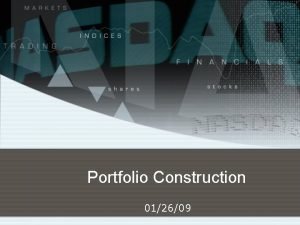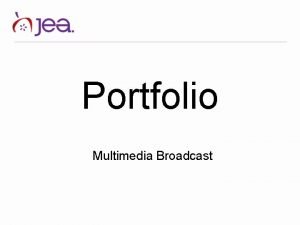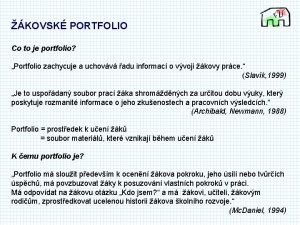Aligning Projects with Organizational Strategy The Portfolio Management





























































- Slides: 61

Aligning Projects with Organizational Strategy The Portfolio Management Approach – An Overview Dr. George Sifri D. B. A. , PMP, CCP, CISA, CM, PSP, EVP, CCE, PMI-RMP, PMI-SP gsifri@ieee. org ESI-PMI-AGC-BAHRAIN-0612 © June 2012 ESI. All rights reserved. 1

Learning Objectives • At the end of this seminar the participants should be able to: 1. Define vocabulary of strategic management 2. Define a portfolio, and portfolio management 3. Describe a portfolio approach and how it can be implemented through portfolio management 4. Provide an overview of the portfolio management process 5. Describe the two groups of portfolio management processes ESI-PMI-AGC-BAHRAIN-0612 © June 2012 ESI. All rights reserved. 2

What is a Vision Statement? • It is an aspiration around which a strategist might seek to focus the attention and energies of members of the organization • It generally expresses long-term action horizon • It is ambitious and it forces the firm to stretch • Its’ ambiguity allows flexibility for changing strategy or implementation tactics • It answers the apparently simple but challenging question: – “What do we want to become? ” ESI-PMI-AGC-BAHRAIN-0612 © June 2012 ESI. All rights reserved. 3

Example of a Vision Statement Sony’s vision in early 1950’s “becoming the company that most changes the worldwide image of Japanese products as being of poor quality. ” Citi. Bank’s vision in 1915 “the most powerful, the most serviceable, the most far reaching world financial institution the world has ever seen. ” ESI-PMI-AGC-BAHRAIN-0612 © June 2012 ESI. All rights reserved. 4

What is a Mission Statement? • It is a general expression of the overall purpose of the organization • It is ideally is in line with the values and expectations of major stakeholders • It is concerned with the scope and boundaries of the organization • It answers the apparently simple but challenging question: – “What business are we in? ” ESI-PMI-AGC-BAHRAIN-0612 © June 2012 ESI. All rights reserved. 5

Example of a Mission Statement e. Bay’s “To provide a global trading platform where practically anyone can trade practically anything. “ Amazon’s “To build a place where people can come to find and discover anything they might want to buy online. ” Google’s “To organize the world’s information and make it universally accessible and useful. ” ESI-PMI-AGC-BAHRAIN-0612 © June 2012 ESI. All rights reserved. 6

Business Goals, Business Objectives, and Business Targets • A Business goal usually means a general aim in line with the mission: – It may well be qualitative in nature – It answers the question: • Why do we want to tackle this initiative? • Business objectives translate goals into specific, and measureable criteria to answer the question: – How do we know that we achieved the business goals? ESI-PMI-AGC-BAHRAIN-0612 © June 2012 ESI. All rights reserved. 7

Examples of Business Goals, and Business Objectives Business Goals Improve profitability Enhance safety Business Objectives within five years KRA KPI Measure Metric Cost Operating Expenses/Unit produced $ < 10% of IA Administration Expenses/Unit sold $ < 5% of IA Sales Gross Revenues from Products $ Sold Increase by 20% Construction Falling Accidents Count BIC Market Share % Increase by 10% Gross Units Sold Count Increase by 5% Improve competitive Customer position Loyalty KRA = Key Result Area KPI= Key Performance Indicator ESI-PMI-AGC-BAHRAIN-0612 BIC= Best in Class IA = Industry Average © June 2012 ESI. All rights reserved. 8

Discussion • What are the differences between objectives and targets? Objectives § § Imperative Subject to a “Management of Change” process If the project’s objectives cannot be achieved or not valid anymore then either the key stakeholders change the project’s objectives or they kill the project They present the needs of the key stakeholders Targets § They represent the expectations of the key stakeholders ESI-PMI-AGC-BAHRAIN-0612 © June 2012 ESI. All rights reserved. 9

What is Strategy? • Strategy is the direction and scope of an organisation over the long term, which achieves advantage in a changing environment through its configuration of resources and competences with the aim of fulfilling stakeholder expectations ESI-PMI-AGC-BAHRAIN-0612 © June 2012 ESI. All rights reserved. 10

Discussion • What do we mean by a strategic competitive advantage? Four criteria for a strategic competitive advantage: 1. Creates value in the eyes of the key stakeholders 2. Rare 3. Costly to imitate 4. Nonsubstitutable ESI-PMI-AGC-BAHRAIN-0612 © June 2012 ESI. All rights reserved. 11

Hierarchical Levels of Strategy Corporate Strategy Business you should be in Business Strategy Tactics to beat the competition Functional Strategy Operational methods to implement the tactics ESI-PMI-AGC-BAHRAIN-0612 © June 2012 ESI. All rights reserved. 12

The Strategic Management Process External Analysis Vision & Mission Long-Term Goals & Objectives Strategic Choice Strategy Implementation Competitive Advantage Internal Analysis ESI-PMI-AGC-BAHRAIN-0612 © June 2012 ESI. All rights reserved. 13

Elements of Strategic Management Strategic capability The environment The strategic position Corporate level strategies Business level strategies Expectations and purposes Organizing Strategy into action Strategic choices Functional level strategies ESI-PMI-AGC-BAHRAIN-0612 Enabling Managing change © June 2012 ESI. All rights reserved. 14

What is a Portfolio? “A collection of projects or programs and other work that are grouped together to facilitate effective management of that work to meet strategic business objectives. ’’ Source: PMBOK® Guide 2008 Edition; page 8 Next > ESI-PMI-AGC-BAHRAIN-0612 © June 2012 ESI. All rights reserved. 15

What is a Portfolio? Source: The Standard for Portfolio Management, PMI 2 nd Edition, page 5, figure 1 -1 ESI-PMI-AGC-BAHRAIN-0612 © June 2012 ESI. All rights reserved. Next > 16

What is a Portfolio? • All components of a portfolio exhibit certain common features: 1. They represent investments made or planned by the organization 2. They are aligned with the organization’s strategic goals and objectives 3. They typically have some distinguishing features that permit the organization to more effective management 4. The components of the portfolio are quantifiable; that is, they can be measured ranked or prioritized ESI-PMI-AGC-BAHRAIN-0612 © June 2012 ESI. All rights reserved. 17

What is Portfolio Management? ‘’The centralized management of one or more portfolios, which includes identifying, prioritizing, authorizing, managing and controlling projects, programs and other related work to achieve specific strategic business objectives. ’’ Source: PMBOK® Guide 2008 Edition; page 9 ESI-PMI-AGC-BAHRAIN-0612 © June 2012 ESI. All rights reserved. 18

Strategic Linkage and Portfolio Balancing Vision Goal 1 Strategy 1. 2 Goal 2 Strategy 1. 3 Strategy 2. 1 Project 1. 1. 1 Project 1. 3. 1 Project 1. 1. 2 Project 1. 3. 2 Project 2. 1 Strategy 2. 2 Goal 3 Strategy 2. 3 Project 2. 2. 1 Project 2. 3. 1 Project 2. 2. 2 Project 2. 3. 2 Strategy 2. 4 Strategy 3. 1 Project 1. 1. 3 ESI-PMI-AGC-BAHRAIN-0612 © June 2012 ESI. All rights reserved. 19

Example of Strategic Linkage Vision Growth to $ 5 Billion Acquisitions Developing sales channels in Asia Buy & integrate Y Research and recommend 3 channels Buy & integrate Z Establish IP security ESI-PMI-AGC-BAHRAIN-0612 Improved customer satisfaction Increased $ from new products Continuous customer participation in our decisions Building industryleading competence in X Establish 5 customer involvement centers © June 2012 ESI. All rights reserved. Fund university collaborative X Build sustainable recurring program 20

Discussion • What are the requirements for effective portfolio management? 1. 2. 3. 4. 5. Clarity on delegation of authority; single point of accountability for project selection Clearly define process and guidelines for project selection and budgets Clearly defined goals, objectives, and targets both strategic and operational Supporting behavior exhibited by key stakeholders Accurate, timely, and relevant information for decision making ESI-PMI-AGC-BAHRAIN-0612 © June 2012 ESI. All rights reserved. 21

Portfolio Management Process Groups • Aligning process group – This group determines how components will be categorized, evaluated and selected for inclusion, and managed in the portfolio • Monitoring and controlling process group – The group reviews performance indicators periodically for alignment with strategic objectives Next > ESI-PMI-AGC-BAHRAIN-0612 © June 2012 ESI. All rights reserved. 22

Aligning Process Group Overview • The group consists of the following processes: 1. 2. 3. 4. 5. 6. 7. 8. Identify components Categorize components Evaluate components Select components Prioritize components Balance portfolio Communicate portfolio adjustment Authorize components ESI-PMI-AGC-BAHRAIN-0612 © June 2012 ESI. All rights reserved. 23

Identification • Key activities include: 1. Comparing ongoing components and new component proposals with a predetermined component definition and related key descriptors 2. Rejecting components that do not fit within the predetermined definition 3. Classifying identified components into predefined classes of components, such as project, program, portfolio, and other works ESI-PMI-AGC-BAHRAIN-0612 © June 2012 ESI. All rights reserved. 24

Contents of a Business Case q. Executive summary q. Business requirements q. Cost benefits analysis q. Risk management ESI-PMI-AGC-BAHRAIN-0612 © June 2012 ESI. All rights reserved. 25

Business Requirements • What is the business problem that the project is trying to address? • What other projects or systems that may be effected by this project? • How does this project link to the business strategy? • How does this project impact partners, business units, functional divisions, etc? • Why is the organization doing this project? • Who will benefit from this project? • Why do the project now? • What are the success criteria of this project? • How do we know that the business need is satisfied? ESI-PMI-AGC-BAHRAIN-0612 © June 2012 ESI. All rights reserved. 26

Cost Benefit Analysis • • • What are the tangible and the intangible project benefits? How to quantity costs and benefits whenever possible? Do you have at least two viable alternatives to solve the problem? What are the costs and the benefits associated with each alternative? How well each alternative solve the problem? Which alternative is the preferred one and why? Under what conditions the next alternative in the list becomes the preferred alternative? What are the costs to other partners or customers? What are the basis for the costs estimate? How much will this project cost to implement and maintain? How much will this project save? ESI-PMI-AGC-BAHRAIN-0612 © June 2012 ESI. All rights reserved. 27

Risk Management • • • What are the active risks? What are the dormant risks? Do we have responses to active risks in place? Is the level of residual risks acceptable to approve the project to move to the next phase? Are there any show stoppers? Are there any specific responses that must be implemented before moving to the next phase? What are the chances that this project will be successful? What will be done to maximize the chances for success? Is there enough reserve and contingency in the budget and schedule? ESI-PMI-AGC-BAHRAIN-0612 © June 2012 ESI. All rights reserved. 28

Categorize Components • Key activities include: 1. Identifying strategic categories based on the strategic plan 2. Comparing identified components to the categorization criteria 3. Grouping each component into only one category ESI-PMI-AGC-BAHRAIN-0612 © June 2012 ESI. All rights reserved. 29

Discussion • Give examples of categories that may be used to group and compare a portfolio’s components Categories Subcategories § § § Increased profitability (revenue increase, cost reduction, etc. ) Risk reduction Efficiency improvement Legal obligation Market share increase Process improvement Continuous improvement Business imperatives (e. g. IT compatibility ) ESI-PMI-AGC-BAHRAIN-0612 § © June 2012 ESI. All rights reserved. Size (e. g. , effort budget) Duration Component type (e. g. , projects, programs, other work) Phase 30

Evaluate Components • Key activities include: 1. Evaluating components with a scoring model comprising weighted key criteria 2. Producing graphical representations to facilitate decision-making in the selection process 3. Making recommendations for the selection process ESI-PMI-AGC-BAHRAIN-0612 © June 2012 ESI. All rights reserved. 31

Project Scoring Model © 2003 The Mc. Graw-Hill Companies, Inc. , All Rights Reserved. ESI-PMI-AGC-BAHRAIN-0612 © June 2012 ESI. All rights reserved. Next > 32

Project Scoring Model Total project score (70 of 100 points) Project deliverable (30 of 40 points) Total cost (5 of 10 points) Value to the organization (40 of 60 points) Financial (20 of 24 points) Strategic (20 of 36 points) Duration ( 5 of 8 points) ROI ( 6 of 8 points) Competitive issues ( 4 of 6 points) Scope (10 of 12 points) Payback period (4 of 4 points) New business issues (10 of 12 points) Quality (10 of 10 points) Benefit/Cost Ratio (10 of 12 points) Capability improvement (6 of 18 points) ESI-PMI-AGC-BAHRAIN-0612 © June 2012 ESI. All rights reserved. 33

Example of Building a Scoring Model for R&D Projects • Example applied to R&D project: M = Total market size S = Potential market share T = Probability of technical success C = Project cost Score = T * ( M + 2 * S ) / C ESI-PMI-AGC-BAHRAIN-0612 © June 2012 ESI. All rights reserved. 34

Graphical Representation Source: The Standard for Portfolio Management, PMI 2 nd Edition, page 59, figure 4 -7 ESI-PMI-AGC-BAHRAIN-0612 © June 2012 ESI. All rights reserved. 35

Select Components • Key activities include: 1. Selecting components based on the evaluation results and comparison to selection criteria 2. Producing a list of components for prioritization ESI-PMI-AGC-BAHRAIN-0612 © June 2012 ESI. All rights reserved. 36

Discussion • What are some of the required supporting behaviors of the evaluation and selection team? § Understand the business context and strategy § Consider multiple options and scenarios of future outcomes § Develop and implement a consistent and objective approach to option comparisons § Assess the viability of the project § Assess the investment quality versus risk and uncertainty ESI-PMI-AGC-BAHRAIN-0612 © June 2012 ESI. All rights reserved. 37

© 2003 The Mc. Graw-Hill Companies, Inc. , All Rights Reserved. ESI-PMI-AGC-BAHRAIN-0612 © June 2012 ESI. All rights reserved. 38

Project Selection and Prioritization Methods Categories • The methods used for project selection discussed in this module can be categorized as follows: – Ranking – Economic Decision Theory Models Next > ESI-PMI-AGC-BAHRAIN-0612 © June 2012 ESI. All rights reserved. 39

Project Selection Methods Categories Ranking Techniques Pairwise Comparison Scoring Models Project Selection Methods Categories Net Present Value (NPV) Economic Decision Theory Models Internal Rate of Return (IRR) Discounted Payback Period (DPP) Investment Efficiency (IE) ESI-PMI-AGC-BAHRAIN-0612 © June 2012 ESI. All rights reserved. 40

Pairwise Comparison - Dominance Count Total Votes 9 for A 7 for B 8 for 6 for 10 for C D E ESI-PMI-AGC-BAHRAIN-0612 A A 2 B B 3 A 2 C 1 A 3 D 1 C 3 B 1 D 3 A 2 E 2 C D 1 B 1 E 3 D D 1 C 2 E 2 © June 2012 ESI. All rights reserved. E 3 E 41

Economic Decision Theory • Attempt to evaluate projects on their contribution to the firm’s profits • Take into account the cash flow involved with the project from initiation, through development, to sales, and either end-of-life cycle or some specified time horizon • Methods include: – Discounted cash flow models such as Net Present Value – Internal rate of return – Payback period ESI-PMI-AGC-BAHRAIN-0612 © June 2012 ESI. All rights reserved. 42

Economic Indicators in Action Net Present Value Demolish Operation De-commission Discounted Payback Period Commission Procure and Construct Design Pre-project Cumulative PV + Reduced OPEX Asset Life Cycle - Reduced cycle time Reduced CAPEX ESI-PMI-AGC-BAHRAIN-0612 Maximum Discounted Cumulative Cash Exposure © June 2012 ESI. All rights reserved. 43

Prioritize Components • Key activities include: 1. Confirming the classification of components in accordance with predetermines strategic categories 2. Assigning scoring or weighting criteria for ranking components 3. Determining which components should receive highest priority within the portfolio ESI-PMI-AGC-BAHRAIN-0612 © June 2012 ESI. All rights reserved. 44

Balance Portfolio • Key activities include: 1. Adding new components that have been selected and prioritized for authorization 2. Identifying components that are not authorized based on the review process 3. Eliminating components to be suspended, reprioritized, or terminated based on the review process ESI-PMI-AGC-BAHRAIN-0612 © June 2012 ESI. All rights reserved. 45

Communicate Portfolio Adjustment • Key activities include: 1. Communicating portfolio decisions to key stakeholders, both for components included in and those excluded from the portfolio 2. Acquainting stakeholders with the communications plan which may include review cycles, timelines, etc 3. Communicating expected and actual portfolio results, identifying variances and corrective action ESI-PMI-AGC-BAHRAIN-0612 © June 2012 ESI. All rights reserved. 46

Authorize Components • Key activities include: 1. Communicating portfolio balancing decisions to key stakeholders, both for components included and those not included in the portfolio 2. Authorizing selected components and inactivating or terminating components of the portfolio 3. Reallocating budget and resources for inactive and terminated components 4. Allocating financial and human resources to execute selected portfolio components 5. Communicating expected results ESI-PMI-AGC-BAHRAIN-0612 © June 2012 ESI. All rights reserved. 47

Monitoring and Controlling Process Group Overview • The group consists of the following processes: 1. Review and reportfolio performance 2. Monitor business strategy changes ESI-PMI-AGC-BAHRAIN-0612 © June 2012 ESI. All rights reserved. 48

Review and Report Portfolio Performance • Key activities include: 1. Reviewing component sponsorship, accountability, and other ownership criteria against organizational governance standards 2. Reviewing components priority, dependencies, scope, expected return, risks, and financial performance against portfolio control criteria and organizational value and investment criteria 3. Reviewing expected impact of business forecasts, resource utilization, and capacity constraints on portfolio performance Next > ESI-PMI-AGC-BAHRAIN-0612 © June 2012 ESI. All rights reserved. 49

The Business View of Portfolio Management ESI-PMI-AGC-BAHRAIN-0612 © June 2012 ESI. All rights reserved. 50

Portfolio Metrics Category Key Questions Sample Metrics Portfolio Mix Is our funding aligned with strategic objectives? § § § % of Portfolio spend in “run the business” % of Portfolio in “grow the business” % of Portfolio in “innovate the business” % of Portfolio in Short/Medium/Longterm projects % of portfolio in Large and Extra Large Projects Next > ESI-PMI-AGC-BAHRAIN-0612 © June 2012 ESI. All rights reserved. 51

Portfolio Metrics Category Key Questions Sample Metrics Demand capacity Do we have the right prioritization and sequencing of projects given current capacity? § § § Value For our portfolio, to what extent did we achieve our objectives? § § % of growth in project intake % of growth in initiatives Resource utilization (human, material, capital) Recruiting pipeline Production capacity % on time % on budget Portfolio and subportfolio IRR $ saved for consolidation efforts Next > ESI-PMI-AGC-BAHRAIN-0612 © June 2012 ESI. All rights reserved. 52

Portfolio Metrics Category Key Questions Sample Metrics Portfolio health For programs/projects inflight, how is our execution progressing? § § Financial management ESI-PMI-AGC-BAHRAIN-0612 How effectively are we managing program and project budgets and what are the financial trends? © June 2012 ESI. All rights reserved. § § § Counts and amounts for programs and projects # of issues by severity % variance to plan % funding in-flight $ committed but not spent 53

Graphical Representations • Progress measurement techniques can also use graphical representations to help compare desired and/or planned situations with actual situations • A typical graphical tool used is the “traffic light” analogy – Green: evaluation/forecast situation in line with desired results – Yellow: some difficulty encountered/perceived but effective corrective action possible or being implemented – Red: critical situation calling for replanning, an urgent intervention, that might even include postponing implementation or terminating the component ESI-PMI-AGC-BAHRAIN-0612 © June 2012 ESI. All rights reserved. 54

Traffic Light Analogy ESI-PMI-AGC-BAHRAIN-0612 © June 2012 ESI. All rights reserved. 55

Radar Graphs Source: The Standard for Portfolio Management, PMI 2 nd Edition, page 81, figure 4 -18 ESI-PMI-AGC-BAHRAIN-0612 © June 2012 ESI. All rights reserved. 56

Monitor Business Strategy Changes Scanning Determining the timing and importance of environmental changes and trends for firms’ strategies and their management Assessing Portfolio Register Forecasting ESI-PMI-AGC-BAHRAIN-0612 Identifying early signs of environmental changes and trends Monitoring Detecting meaning through ongoing observations of environmental changes and trends Developing projections of anticipated outcomes based on monitored changes and trends © June 2012 ESI. All rights reserved. 57

Portfolio Rebalancing Recommendations • Ensure that the organization continues to invest in only those portfolio components that support strategic goals and objectives • Verify that those investments remain on-track to achieve stated strategic goals and objectives • Recommendations are input to Strategic Change process: – Realign – Discontinue Next > ESI-PMI-AGC-BAHRAIN-0612 © June 2012 ESI. All rights reserved. 58

Successful Project Portfolio Management How well are we executing? Are we investing in the right things? Successful Project Portfolio Management Are we optimizing our capacity? ESI-PMI-AGC-BAHRAIN-0612 Can we absorb all the changes? Are we realizing the promised benefits? © June 2012 ESI. All rights reserved. 59

Lessons Learned • Even ‘‘mandatory’’ projects have options • Engaging business leaders in an open, fact-based dialogue is a key outcome of PPM • When seeking to implement resource management for the first time, focus on a staged approach, using quick wins to build momentum and buy-in • Individual project business cases can be compelling, but we need to look at the entire portfolio pipeline to determine the best course of action for the company • Change may impact technology, physical assets, or people; people are the ones who get unsettled by change ESI-PMI-AGC-BAHRAIN-0612 © June 2012 ESI. All rights reserved. 60

ESI-PMI-AGC-BAHRAIN-0612 © June 2012 ESI. All rights reserved. 61
 Aligning hr strategy with business strategy
Aligning hr strategy with business strategy Aligning training with strategy
Aligning training with strategy Blueprint for overnight hotel stay service
Blueprint for overnight hotel stay service Benefits of aligning whmis with ghs
Benefits of aligning whmis with ghs Aligning brand and culture
Aligning brand and culture Aligning service design and standards
Aligning service design and standards Influences of organizational structures on projects
Influences of organizational structures on projects Customer portfolio matrix
Customer portfolio matrix Non financial criteria for project selection
Non financial criteria for project selection Weebly teaching portfolio
Weebly teaching portfolio Telecommunications project management
Telecommunications project management What is project portfolio matrix
What is project portfolio matrix Cost management in agile projects
Cost management in agile projects Digitization workflow
Digitization workflow Organizational strategy types
Organizational strategy types Cognitive hurdle
Cognitive hurdle Political hurdle
Political hurdle How does organizational strategy determine is requirements
How does organizational strategy determine is requirements Linking organizational strategy to hr planning
Linking organizational strategy to hr planning Hình ảnh bộ gõ cơ thể búng tay
Hình ảnh bộ gõ cơ thể búng tay Slidetodoc
Slidetodoc Bổ thể
Bổ thể Tỉ lệ cơ thể trẻ em
Tỉ lệ cơ thể trẻ em Gấu đi như thế nào
Gấu đi như thế nào Tư thế worm breton là gì
Tư thế worm breton là gì Bài hát chúa yêu trần thế alleluia
Bài hát chúa yêu trần thế alleluia Môn thể thao bắt đầu bằng chữ f
Môn thể thao bắt đầu bằng chữ f Thế nào là hệ số cao nhất
Thế nào là hệ số cao nhất Các châu lục và đại dương trên thế giới
Các châu lục và đại dương trên thế giới Công của trọng lực
Công của trọng lực Trời xanh đây là của chúng ta thể thơ
Trời xanh đây là của chúng ta thể thơ Mật thư anh em như thể tay chân
Mật thư anh em như thể tay chân Phép trừ bù
Phép trừ bù Phản ứng thế ankan
Phản ứng thế ankan Các châu lục và đại dương trên thế giới
Các châu lục và đại dương trên thế giới Thơ thất ngôn tứ tuyệt đường luật
Thơ thất ngôn tứ tuyệt đường luật Quá trình desamine hóa có thể tạo ra
Quá trình desamine hóa có thể tạo ra Một số thể thơ truyền thống
Một số thể thơ truyền thống Bàn tay mà dây bẩn
Bàn tay mà dây bẩn Vẽ hình chiếu vuông góc của vật thể sau
Vẽ hình chiếu vuông góc của vật thể sau Biện pháp chống mỏi cơ
Biện pháp chống mỏi cơ đặc điểm cơ thể của người tối cổ
đặc điểm cơ thể của người tối cổ Thế nào là giọng cùng tên?
Thế nào là giọng cùng tên? Vẽ hình chiếu đứng bằng cạnh của vật thể
Vẽ hình chiếu đứng bằng cạnh của vật thể Vẽ hình chiếu vuông góc của vật thể sau
Vẽ hình chiếu vuông góc của vật thể sau Thẻ vin
Thẻ vin đại từ thay thế
đại từ thay thế điện thế nghỉ
điện thế nghỉ Tư thế ngồi viết
Tư thế ngồi viết Diễn thế sinh thái là
Diễn thế sinh thái là Các loại đột biến cấu trúc nhiễm sắc thể
Các loại đột biến cấu trúc nhiễm sắc thể Số nguyên tố là
Số nguyên tố là Tư thế ngồi viết
Tư thế ngồi viết Lời thề hippocrates
Lời thề hippocrates Thiếu nhi thế giới liên hoan
Thiếu nhi thế giới liên hoan ưu thế lai là gì
ưu thế lai là gì Sự nuôi và dạy con của hổ
Sự nuôi và dạy con của hổ Khi nào hổ con có thể sống độc lập
Khi nào hổ con có thể sống độc lập Sơ đồ cơ thể người
Sơ đồ cơ thể người Từ ngữ thể hiện lòng nhân hậu
Từ ngữ thể hiện lòng nhân hậu Thế nào là mạng điện lắp đặt kiểu nổi
Thế nào là mạng điện lắp đặt kiểu nổi Business strategy vs corporate strategy
Business strategy vs corporate strategy

